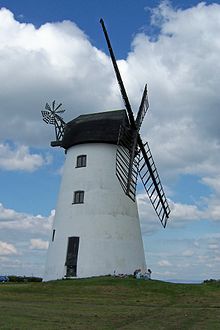- Little Marton Mill
-
Little Marton Mill 
Origin Mill location Blackpool, Lancashire Grid reference SD 349 341 Coordinates 53°47′57″N 2°59′23″W / 53.7991°N 2.9898°WCoordinates: 53°47′57″N 2°59′23″W / 53.7991°N 2.9898°W Year built 1838 Information Purpose Corn mill Type Tower mill Storeys Four Number of sails Four Fantail blades Eight Little Marton Mill is a 19th-century English tower windmill in Marton, now part of Blackpool, Lancashire. It was built in 1838 by John Hays for grinding corn, and worked until 1928. It has been designated a Grade II listed building by English Heritage.[1]
Contents
History and assessment
Little Marton Mill was built in 1838 by millwright John Hays for John Whalley, on the site of a previous mill.[2][3] It was once one of several gristmills in the area, and is the last remaining of perhaps four mills that once stood within the current boundaries of Blackpool.[4] The hamlet of Little Marton was part of the township of Marton which, by the end of the 19th century, was incorporated into Blackpool and St Anne's-on-the-Sea.[5] Marton had a watermill until the mid-18th century, and another wind-powered gristmill up to the late 19th century, both at Great Marton.[4] Little Marton Mill was later worked by a miller named Cornelius Bagot.[2] It stopped working in September 1928.[6] Bagot restored the mill and in 1937 gave it to the Allen Clarke Memorial Fund as a memorial to local teacher, writer and windmill enthusiast Allen Clarke (1863–1935).[2][7] The mill was extensively renovated in 1987 at a cost of £88,000.[2]
Little Marton Mill is situated on a green, close to the M55 motorway and is a familiar landmark on this major route into the seaside resort.[2][8] English Heritage designated the windmill a Grade II listed building on 20 October 1983.[1] The Grade II designation—the lowest of the three grades—is for buildings that are "nationally important and of special interest".[9]
Structure
For a general explanation of the elements of windmill machinery, see Mill machinery.Little Marton Mill is of a typical style for windmills built in the Fylde. On four storeys (including a basement), it has a circular plan and a broad base in proportion to its height. It is constructed of stuccoed, whitewashed brick.[1][8] On the exterior wall there is a commemorative plaque to local writer Allen Clarke.[2] The mill is entered through double doors (at basement level) to the east, and a single door to the west.[1] There are square windows at the first, second and third storeys.[1]
Typically for Fylde windmills, the cap (replaced in 1987) is boat-shaped.[1][2] There are four sails and a fantail with eight blades. The machinery is incomplete as some of it is now at Lytham Windmill.[2]
See also
- List of windmills in Lancashire
- Listed buildings in Blackpool
References
- Footnotes
- ^ a b c d e f "Little Marton Mill", National Heritage List for England (English Heritage), http://list.english-heritage.org.uk/resultsingle.aspx?uid=1205764, retrieved 25 June 2011
- ^ a b c d e f g h Dunkerley, Paul, "Little Marton Mill", Engineering Timelines, http://www.engineering-timelines.com/scripts/engineeringItem.asp?id=655, retrieved 25 June 2011
- ^ Lancashire County Council & Egerton Lea Consultancy (2005), p. 3
- ^ a b Lancashire County Council & Egerton Lea Consultancy (2005), p. 25
- ^ Farrer & Brownbill (1912), pp. 239–242
- ^ Her Majesty's Stationery Office, p. 132
- ^ Berry, Mark (25 May 2011). "Little Marton windmill, Lancashire". Windmill World. http://www.windmillworld.com/millid/1463.htm. Retrieved 1 July 2011.
- ^ a b Hartwell & Pevsner, p. 163
- ^ "Listed Buildings", National Heritage List for England (English Heritage), http://www.english-heritage.org.uk/caring/listing/listed-buildings/, retrieved 13 June 2011
- Sources
- Lancashire County Council and Egerton Lea Consultancy (April 2005), "Blackpool Historic Town Assessment Report", Lancashire Historic Town Survey Programme (Lancashire County Council Environment Directorate), http://www.lancashire.gov.uk/environment/documents/historictowns/BlackpoolComplete_LowRes.pdf, retrieved 25 October 2010
- Farrer, William; Brownbill, J., eds. (1912), "Townships — Marton", A History of the County of Lancaster: Volume 7 (Constable), OCLC 59626695, http://www.british-history.ac.uk/report.aspx?compid=53227
- Hartwell, Clare; Pevsner, Nikolaus (2009) [1969]. Lancashire: North. New Haven and London: Yale University Press. ISBN 0300126670.
- Agriculture (Her Majesty's Stationery Office) 63, 1957, OCLC 1478576
External links
 Media related to Little Marton Mill at Wikimedia Commons
Media related to Little Marton Mill at Wikimedia Commons- Friends of Little Marton Windmill
Categories:- Buildings and structures in Blackpool
- Grade II listed buildings in Lancashire
- Grade II listed windmills
- Windmills in Lancashire
- The Fylde
- Tower mills
- Buildings and structures completed in 1838
Wikimedia Foundation. 2010.
